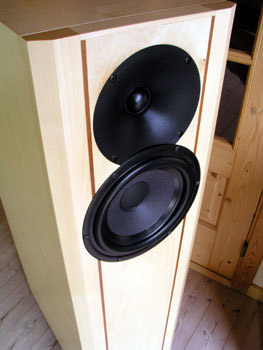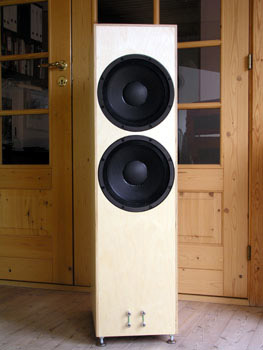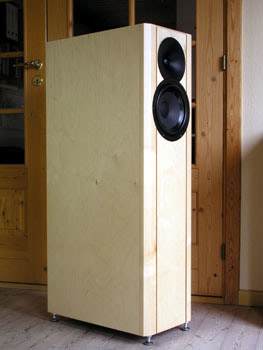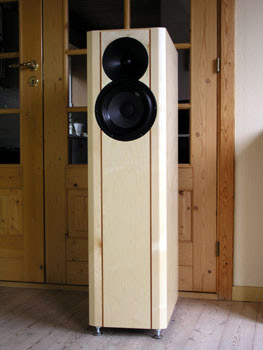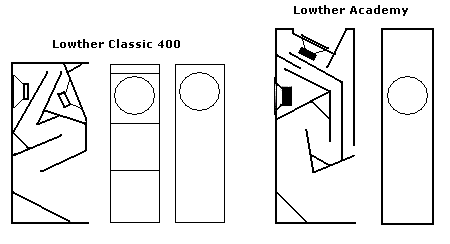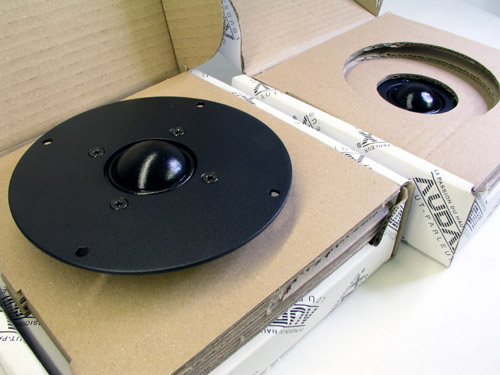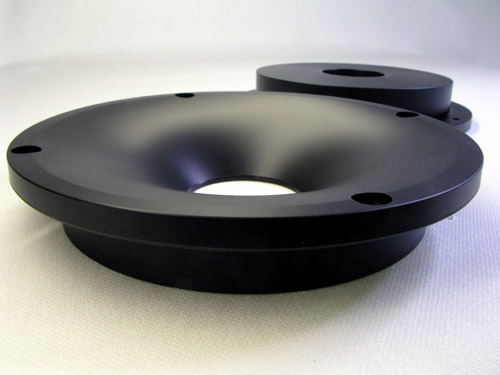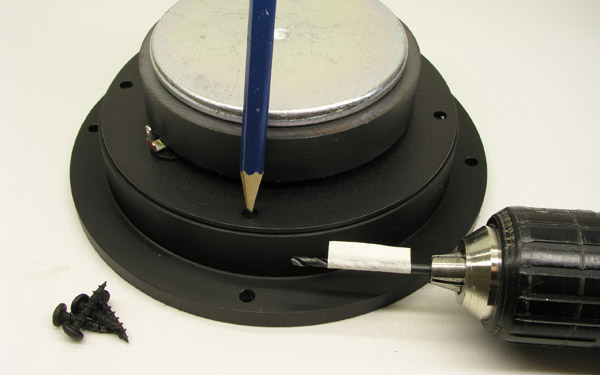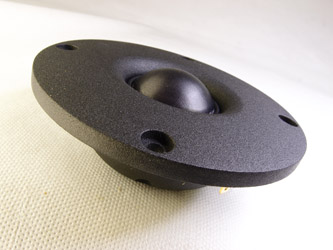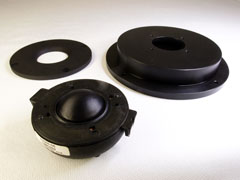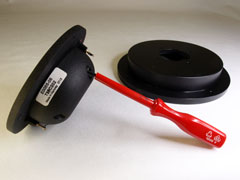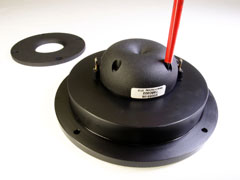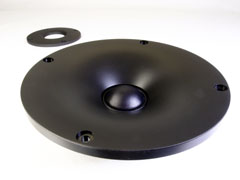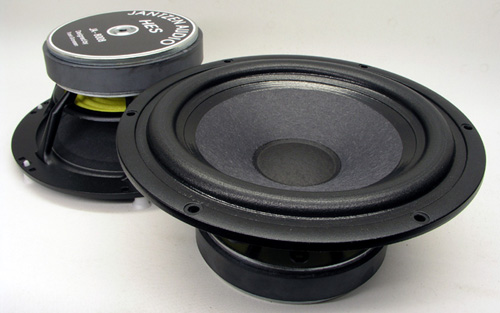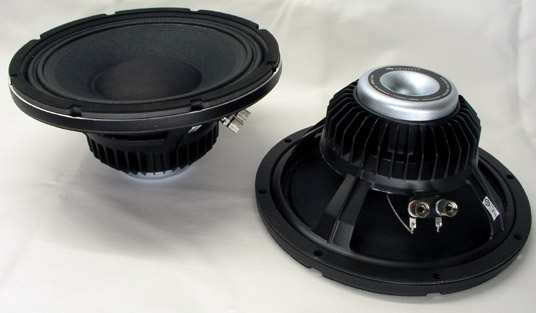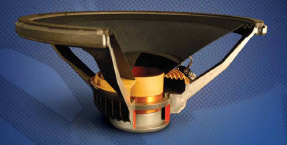DTQWT
mkII
DTQWT mkII replaced by new
DTQWT mkIII
THE DRIVERS CROSSSOVER CABINET DTQWT MODE OF ACTION MEASUREMENTS JA8008 + TW034 + Eminence DeltaLite II 2510, 95 dB high-efficiency, 3-way speaker system The DTQWT mkII is a revised version of the
DTQWT construction having a new 2nd order high-pass
filter to the tweeter, where DTQWT uses 3rd order. |
|||
|
INTRO 150 liter brutto volume is what you have to be prepared for should you decide to follow. From the front it seems fairly modest, 28 cm wide and 105 cm high, but depth is 50 cm and it will require some 20-25 cm minimum to the rear wall to breathe. Overall sensitivity is 95 dB/2.8 volts and having a minimum impedance of 6 ohms, it can be driven by low-wattage SET amps. I do not recommend 2-4 watts SET amps; these amps need 98-100 dB speakers, no matter what manufacturers may claim. I have no trouble driving the DTQWTs from my 8 wpc 300B SET amp. Deep bass - and that very special 300B midrange. With a proper 300B SET amp you can play these speakers for hours and hours without listening fatigue, a sign of low distortion and proper balancing of drivers. 20 watts do even better in terms of bass slam and punch. For a DTQWT amp review, please read here. In many ways life gets easier
when we make big speakers. We have more drivers, bigger
drivers and distortion may all of a sudden be reduced
significantly as none of the drivers have to move much to
produce high sound levels, and we don't have to rely on
drivers being capable of large cone excursions either. The DTQWT construction is based on the TQWT construction supplemented by two 10" Eminence Deltalite II 2510 bass drivers added, providing a total membrane area exceeding a 15" driver. The front drivers and crossovers are the same as for TQWT. The rear bass drivers are fed from a simple 1st order crossover. It is thus possible to up-grade an existing JA8008/TQWT design by building new cabs and buying four bass drivers, 2 coils, 2 caps and 2 resistors, that's all. So, what's a double tapered
quarter wave tube (DTQWT)? Well, nothing new
under sun. The quarter wave tube, transmission line - or
Voigt pipe - came up around 1930 thanks to Paul
Voigt. A tube having a length of 25% of the
driver's resonance frequency, i.e. if we have a driver
with Fs = 40, we would need a pipe of 34400/40/4 = 215 cm
length (34400 = velocity of sound in air in
centimeters/second). This doesn't necessarily mean we must use a
Fz = 40 Hz driver to 40 Hz horn. We can load a horn with whatever we
want except that drivers with a very high Qt may perform better in a
traditionally stuffed transmission line. The DTQWTs were tried with
10" drivers having a Qt = 1.2 (brought in by DTQWT customer) and
the bass simply became too boomy (too low electrical damping).
Loading a tapered tube or transmission line can be done in numerous ways and nothing prevents us from using multiple drivers loading the horn - even from drivers having different size. Same thing can be seen in some bass reflex designs where we find e.g. 10" and 12" in same cabinet, sharing the same port. DTQWT
mode of action DTQWT is in principle a 2-way with
integrated subwoofers, thus no high-pass filter on the main front
driver. This has the indisputable advantage of not needing any series
capacitors, which would be excessively expensive if of good quality
and sonically inferior to no caps, no matter how good the caps are. Despite
the description above, many people have trouble understanding why
we don't need bass drivers with huge Xmax and low Fs. Please compare
the combined membrane area to an e.g. 10" bass driver in a vented
cabinet with the DTQWT. Here we have some 2 x 330 cm^2 from the bass
drivers and 220 cm^2 from the front driver, in total 880 cm^2. This is
2.6 times the membrane area of a single 10" driver. If a single
10" bass-reflex loaded driver has to move +/- 5 mm, we only need
5/2.6= +/- 1.9 mm. Next, all drivers in the DTQWT loads a horn, an
acoustic transformer. Wikipedia:
A horn loudspeaker is a complete loudspeaker or loudspeaker element
which uses a horn to increase the overall efficiency of the driving
element, typically a diaphragm driven by an electromagnet. The horn
itself is a passive component and does not amplify the sound from the
driving element as such, but rather improves the coupling efficiency
between the speaker driver and the air. The horn can be thought of as
an "acoustic transformer" that provides impedance matching
between the relatively dense diaphragm material and the air of low
density. The result is greater acoustic output from a given driver. Initially the DTQWT was built with a single 10" bass driver, providing a system impedance of ~4 ohms minimum, not something that should make most decent low-wattage amps uncomfortable considering the overall system sensitivity. My 20 wpc PSE mono-blocks (6AS7 triodes) did well, but adding a second unit in series with the first driver left no doubt that the amps felt better about ~6 ohms minimum. Actually they felt much better and I admit I was a bit surprised by the difference. Distortion was significantly reduced at (very) high levels and the grip on the bass drivers significantly improved. Possibly the reduced cone motion from having two bass drivers also reduces back-EMF (back-electro-motive-force) and SET amps have low damping factor with poor grip on bass drivers compared to push-pull valve amps or solid state amps. Obviously my solid state amps didn't care at all whether seeing 4 or 6 ohms.
The story behind the front drivers can be read here: TQWT
SEAS T35C002 option
Should you want to try out the new SEAS T35C002
tweeter in replacement of the Audax dome, click above link and read my
comments and instructions.
|
Eminence DeltaLite II 2510 drivers: Download PD Europe: 138 EUR/ea here at: http://www.thomann.de/gb/eminence_deltalite_ii_2510.htm?partner_id=73572. Good
Old England: 4 x DeltaLite 2510 available here at
LEAN for 405£: USA: |
DTQWT
mkII crossover
Back to index
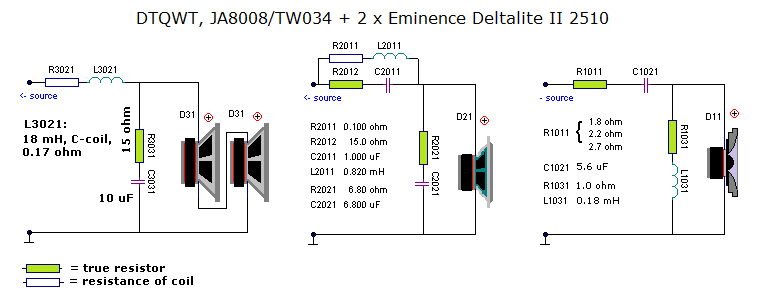
|
As
can be seen, the mid and tweeter section are the same as
for the TQWT
construction. Crossover
topology: |
Changing your mkI crossover to mkII, download image here.
DTQWT drivers and crossover Parts
Back to index
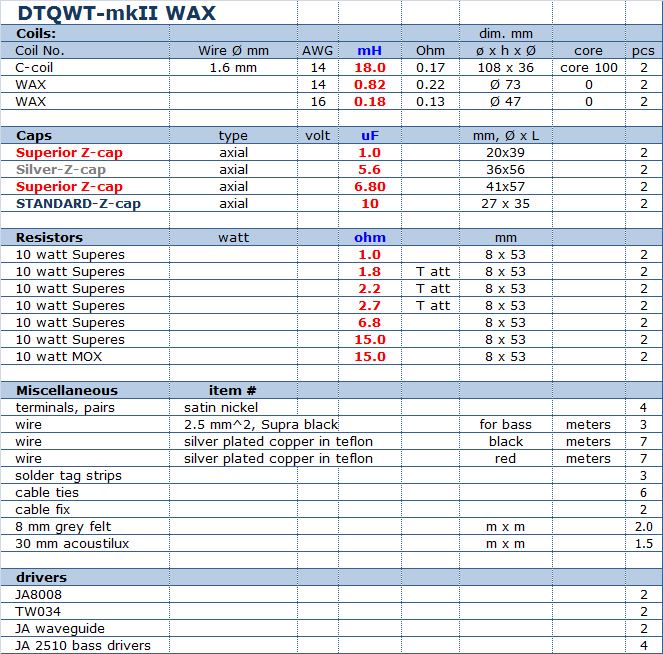
|
If you
want to source damping materials locally, please do not ask where to
buy and what materials are suitable.
I have not been able to find e.g. felt material at the usual diy
speaker suppliers around the world. 10-12 mm polyester foam can be used, but pay attention to the physical
properties of damping materials, some are not specifically meant to absorb sound, rather absorb vibrations from
panels, etc. Do not use damping materials
having a smooth outer surface like damping sheets for cars, etc. These
will reflect sound and are not suitable. |

Jantzen Audio 8 mm felt
and 30 mm polyester foam.
Board for front drivers = 200 x 160 mm; board for bass
section = 200 x 160 mm.
Please
notice that the orientation of an RC circuit (1.0 uF + 15R) in the MT
section can be
either way. RC or CR, doesn't matter, does the same thing.
This also goes for the 10 uF + 15R in the bass crossover, it can be
either way, RC or CR.
I have this question regularly as the photo below is opposite to the
drawing above.
Crossover pics
Crossover for the JA8008/TW034 front drivers is the same as the for TQWT construction.
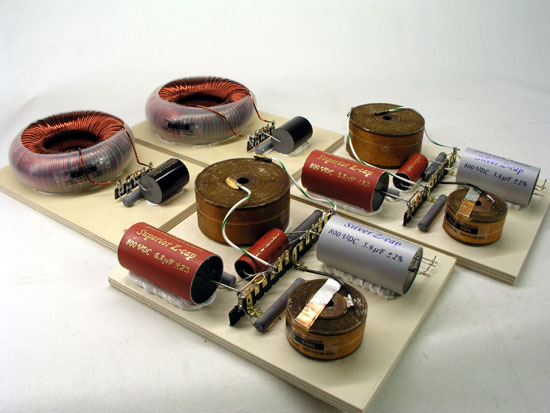
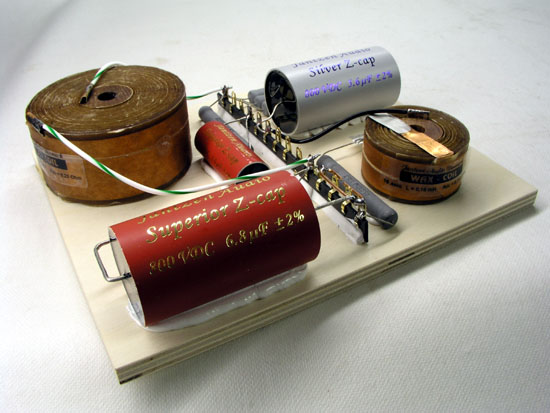
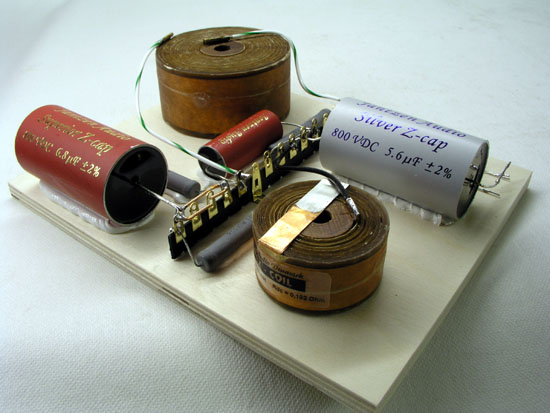
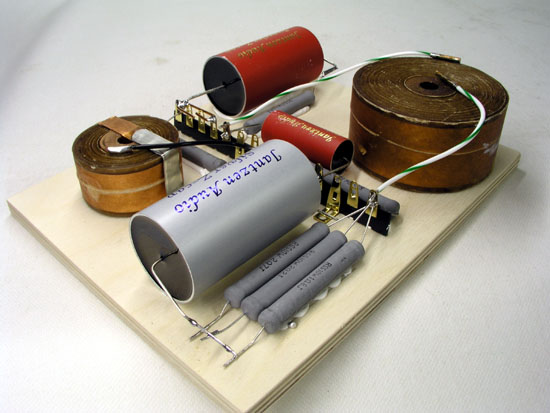
Right: Three resistors here for tweeter
attenuation, 1R8, 2R2 and 2R7. My default is 2R7. Adjust
to personal taste. Click images to view large.
I have learned that some people get confused
by the three resistors on crossover board for tweeter attenuation.
Some builders have connected all three.
Only one of the resistors should be soldered
to the 5.6 uF capacitor. The resistors provide three levels of treble,
low value = high level, high value = low level.
Click images above to view more closely.
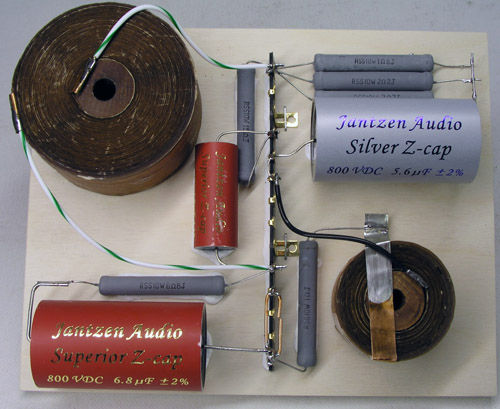
Click image to view
large (2000 pix width)
Crossover for bass drivers
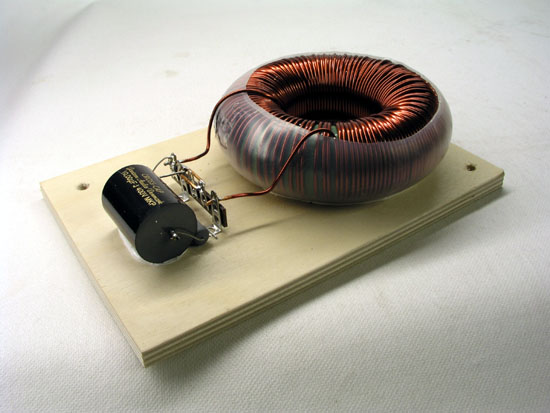
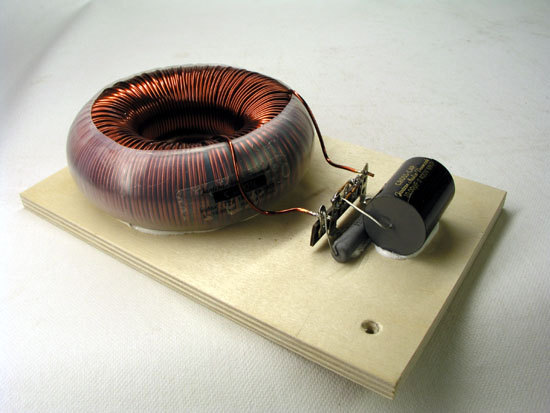
Crossover for the two bass drivers is simplicity
itself: An 18 mH coil in series with the drivers and 10
uF + 15 ohms across
output and ground provides flat impedance for the 1st
order network. Good thing about these large cabs: Lots of
space for crossovers.

Click heading or images to go to cabinet construction
page.
Initially only one bass driver was used, but there is only one thing better than a 10" bass driver: Two! Total membrane area = ~988 cm^2 from 2 x Beyma @ 768 cm^2 plus 1 x JA8008 @ 220 cm^2. A typical 15" driver is around 830 cm^2.
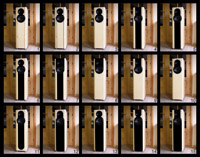
Click image to view large -
and see what
Kjetil in Norway has been thinking about possible front panel designs.
Presenting proper images of bass
capability from this construction is difficult due to
front and rear mounted drivers. Normally we would take
nearfield readings of both drivers and "port"
(horn mouth) and splice the readings at e.g. 100 Hz and
at 350 Hz (JA8008). The port output is usually presented
separately. This approach doesn't work because a
significant part of the lower bass comes from the horn
and in order to measure lower bass we need a measuring
window so wide ( > 100 milli-seconds) that we measure
everything; that is 1) what comes from the drivers and
port - and 2) what is reflected from room boundaries.
Feeding the speaker 31 Hz warble tones leaves no doubt
this speaker has potentials in lower octaves, thus I
placed the speaker in 6 different locations in my
workshop (12 m^2) and used a 320 millisecond window in
the CLIO MLS mode, allowing a lower frequency reading of
3 Hz. My workshop is anything but ideal for this kind of
measurements, but I think the graph provides a useful
sense of bass extension down to around 35 Hz.
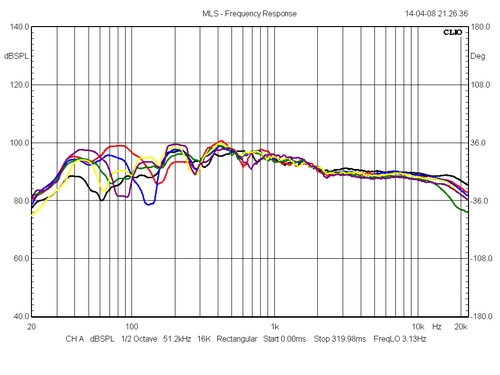
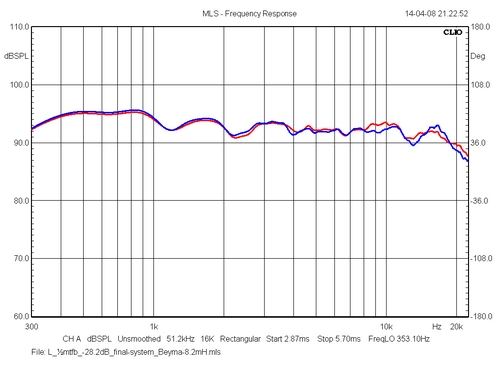
Left: 320 ms reading of speaker in six
different locations. ½ octave smoothing. Right: SPL @ 1
meter, 2.8 volts, left and right speaker. The left graph
also tells how enormously important room placement is for
the response coming from a loudspeaker, and this goes for
any speaker, not only the DTQWT seen here.
Basically the speaker display the exact same performance
as the JA8008/TW034/TQWT construction because the front
drivers and the crossover are exactly the same. View here. What's more interesting is the
impedance plot seen here:
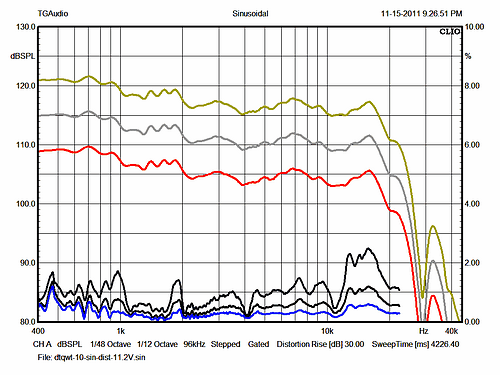
Left: As can been seen from the graph above, we have a minimum 6 ohms impedance (red line inserted) and as stated in the beginning of this article, 8 watts from a SET amp can drive this speaker to significant levels before running into trouble. In fact much louder compared to average home-audio listening level, which is around 85 dB. This does not mean 20 wpc won't do better if you want to play even louder. The DTQWT can play enormously loud before significant distortion occurs. Remember, with 1-2 watt input we may have ~95 dB at 1 metre distance - and this is loud, really loud, but it doesn't mean I recommend 2-4 watts being sufficient. It isn't. Small amps may soon get into clipping no matter what manufacturers may claim.
Right: Distortion (THD) measured at 0.25 meter distance to 8008/TW034 drivers, 1/48 octave intervals, 2R7 to tweeter, 2.8, 5.6 and 11.2 volt input equivalent to 95, 101 and 107 dB at 1 meter. At normal listening level, e.g. 90 dB, we're below 0.5% THD from 500-20000 Hz. Doesn't get much better than this for home audio.
Builders' response on TQWT and DTQWT
